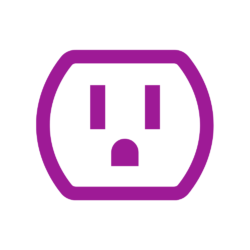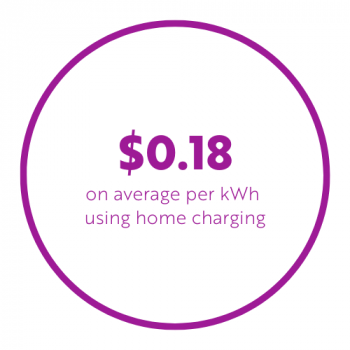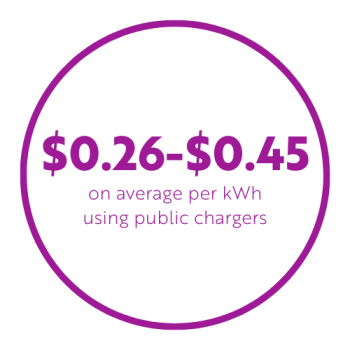Charging with Confidence
Charging Speeds | Charging Costs | Charging Connectors | Charging Tips | Charging Resources
Imagine never needing to stop at a gas station again. For many electric vehicle (EV) drivers, this is a reality! EVs — both battery (BEV) and fuel cell (FCEV) electric vehicles — never need gas. For shorter commutes, plug-in hybrid electric vehicles (PHEV) might not even use gas at all.
Electric vehicle charging is simple, cost-effective and convenient, especially since you can charge up right at home, during work, or while running errands. The act of charging your EV is as simple as the act of charging your phone overnight. Learn the basics of EV charging and find tips to improve your charging experience below.
How long will it take to charge my EV?
Exact charging speed is determined by three factors: the capacity of your EV’s cord, the charging equipment’s power level and the temperature where you’re charging. The length of time to charge up fully at each power level also depends on your EV battery size and the percentage of charge left on the battery when you go to plug in. Remember it is generally recommended that EVs be charged before they hit 30% and should only be charged to 80% to maximize the battery’s lifespan. Check out a side-by-side breakdown of the different power levels and charging speeds below.

Level 1
New EVs come with a portable level 1 charger allowing you to easily plug in on the go to standard 120-volt outlets found in most houses or garages. Unlike higher levels of charging, which require higher voltage outlets to plug into, these level 1 chargers allow you to charge up your EV from the comfort of your home without any additional electrical installations.
The average daily commute of 40 miles should fully recharge overnight, making level 1 charging perfect for those who often don’t need to do much daily driving.

Level 2
Level 2 charging equipment is available in many public areas where vehicles are parked for a significant amount of time — like workplaces, malls and shopping centers. You can also invest in a level 2 home charger that uses a 208 – 240-volt outlet – the same type that most dryers use -to support the higher-powered charging equipment. This may require electrical work to install that higher voltage outlet in a convenient place for charging at your home.
The same 40-mile average daily commute should be replenished in under two hours with level 2 charging. Some states and local regions provide incentives for Home Charging equipment. Find those incentives here.

DC Fast Charging
Direct connect (DC) fast chargers rely on a larger electric grid connection, which delivers power directly to the vehicle, as opposed to Level 1 and 2 chargers which have to convert the current to a lower power level before entering the vehicle. This direct connection results in a much faster and more powerful charge that provides 10 – 20 miles of range per minute. DC fast charging rates are improving as the technology rapidly evolves.
DC fast charging occurs at public and workplace charging stations only and is not available for use at home. Most BEVs come equipped to handle DC fast charging technology, but always check your vehicle’s charging capability and connector before you plug in.
How much will it cost to charge my EV?
The cost of charging an EV depends on many different factors — primarily where you charge and the time of day that you choose to charge, since the price of electricity varies throughout the day. Regardless of whether you charge at home or at a public charger, the cost will be per kilowatt hour (kWh). Overall, charging your EV is significantly less money than filling up a gasoline car.
To better understand the long-term fuel savings of an EV compared with a gas-powered car, check out the US Department of Energy calculator tool and Energy Innovation’s EV fill-up savings tool for charging costs and savings across the U.S.
Home Charging
Public Charging


Electricity prices vary widely across the U.S., with a national average of about 18 cents per kWh.
At this average price, charging an EV with an 80-kWh battery and an average driving range of nearly 300 miles — like the Ford Mustang Mach-E — would only cost about $14.40 to fully charge — from 0% to 100% — at home. Remember, running the battery down to 0% and charging to 100% is not generally recommended.
EV drivers in the U.S. may expect to pay between 26 cents and 45 cents per kWh at a public DC Fast Charger.
At these rates, an EV with a 80-kWh capacity battery would cost between $20.80 and $36.00 to fully charge at a public charger if the battery has been fully depleted and needs to be charged from 0% to 100%. Remember, running the battery down to 0% and charging to 100% is not generally recommended.
Interested in home charging? Compare home chargers and discover home charging incentives available to you.
Which Charging Connector Should I Use?
You’ll need to know which charging connector your EV uses to find the right charging station and adapter to use to properly charge up your vehicle. Today, most battery electric vehicles (BEVs) are already equipped to handle DC fast charging technology, but always check your vehicle’s charging connector before you plug in. There are three main DC fast charging connector types: CHAdeMO, CCS and NACS. As the industry evolves, there is an effort underway to consolidate DC Fast charging connectors to provide a more seamless charging experience for EV drivers.
For the best charging experience, it is important to understand the maximum power level that your EV can safely charge at and the power of the charger you plug into. Discover more quick tips to improve your charging experience here.
DC Fast Chargers
Level 2 Chargers
NACS

CCS

CHAdeMO

J1772

Originally adopted by Tesla, the North American Charging Standard (NACS) charger will be used by every automaker moving forward, with Ford, GM, Toyota, Rivian, Volvo, Polestar, Nissan, Mercedes-Benz, Jaguar Land Rover, Fisker, Hyundai, Stellantis, Volkswagen, and BMW agreeing to adopt it.
The Combined Charging System (CCS, Type 1) plug can be found on many cars currently on the road and at dealerships. However, with Tesla opening up its connector and charging network, the NACS port is being standardized by SAE International. As this technology is phased out, a NACS adaptor will be required to charge.
Standing for “Charge de Move,” CHAdeMO was designed by a collection of automaker industry groups, primarily in Japan.
EV drivers in their Tesla Model Ys, Kia EV6s, and Nissan Leafs with the older “Charge de Move” or CHAdeMO connector will require adaptors to use new charging ports moving forward as the technology is phased out.
The level 2 J1772 type charger is a 240-volt charger. Although level 2 chargers do boast faster charging speeds than level 1 chargers, they are still slower to fully charge than DC fast chargers.
Because level 2 chargers require more time to charge up your EV, they are primarily intended for use while you are charging at home or at work.
What are the types of EV charging adapters?
As the market adjusts to the new charging port standard, adapters are small devices that connect to the plug on your charging cable and can be easily stored in your car for convenience. These adapters will be used often by owners of older models to access all available public charging options. Some dealers include adapters when you buy your car, but it is important to ask for an adapter for both new and used vehicles.
There are two adapter types that are fully tested and approved. The first is the level 2 “J1772-to-NACS” adapter and the second is the “CHAdeMO-to-NACS” adapter.
It is best to use adaptors judiciously and carefully as they add an extra layer to the electric connection between the EV and the charger, can increase the likelihood of electrical faults and can negatively impact functional safety over time.
Improve your — and everyone else’s — charging experience
To prolong the battery life of your EV, you will want to make sure to take good care of it. A new EV with a range of 250-miles is expected to have a 150-to-200-mile range after 12 years of service. Like other types of batteries, EV batteries do degrade over time, though the good news is that they will often outlast the natural life of your vehicle!
By taking a few extra steps to reduce unnecessary wear and tear, you can extend your battery’s lifespan even further and make your charging experience even smoother. Below are a few easy ways to get the most out of your EVs battery.
Start recharging your EV when it hits 30% instead of 0%.
Letting your EV battery fall completely to 0% before recharging will eventually reduce your EV’s overall battery life. Instead, try to start recharging your battery once it hits the 30% charged mark.
Aim for charging only to 80% instead of 100% full.
With the lithium-ion batteries in EVs, charging up to about 80% full helps to maintain your battery’s max capacity more than charging up to 100%. you charge a bit under 100%, it allows plenty of battery space for the energy produced by your EV’s regenerative braking, which converts the kinetic energy from braking into usable energy that helps power your vehicle.
Share and share alike!
Charging infrastructure continues to expand. However, EV drivers can help make existing charging infrastructure more accessible by unplugging from public chargers as soon as their vehicle is charged, sharing available EV chargers and educating other drivers about charging etiquette.
Learn more about best practices and standard charging etiquette here.
Want More Charging Options?
Check Out Home Charging
All homes already have 120-volt plugs to enable level 1 charging; however, most EV drivers enjoy the convenience of a quicker charging experience and choose to install a higher voltage outlet to support a level 2 charger at home. You can search through available level 2 home chargers and learn more about home charging incentives using ElectricForAll.org’s Home Charging Advisor.
Do you live in a multifamily dwelling like an apartment or townhome complex? There are home charging resources available! Residents can learn more about how to advocate for home charging at multifamily properties at Forth’s Charge at Home website!
Learn More About Public Charging
Never fear! There are many great charging station locators and mobile apps that help to locate public charging stations when and where you need it. In fact, there is one charger for every 15 gas stations available in the nation. You can safely anticipate having access to public charging in parking lots and garages at malls, grocery stores, movie theaters, community centers, arenas, hotels and airports.
Check with your EV’s manufacturer and driving manual to find the correct charging options for your vehicle. These are important questions to ask your dealer or manufacturer before you decided to purchase an EV. Some charging networks require a subscription to charge, so look ahead to see what’s available to meet your unique needs before taking off on a long road trip.
Find a public EV charging station near you!
Workplace Charging
If charging at home is not a viable option where you live, or if you just want to “top off” during the day, workplace charging is another convenient option to charge your EV. Many workplaces are already opting to install charging stations, so check with your company to see if this is available to you. If your place of work doesn’t provide charging yet, below are a few resources showing the benefits that you can use to advocate on behalf of adding workplace charging.
If you are a city or county interested in adding public chargers to your area, check out the EV charging station streamlined permitting process video and resources to learn more about how you can increase charging accessibility in your local community.
Do you own or manage a multifamily dwelling that needs charging infrastructure for residents? Look no further! Forth’s Charge at Home website offers all the resources and tools you need to make sure those living at your property not only have access to reliable home charging, but that they can also benefit from cleaner air in and around the property!
See how easy it is to charge? Compare EVs to find out more about range.

